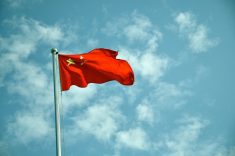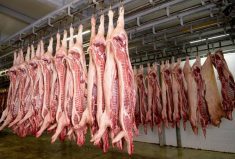Chicago | Reuters — Chicago soybeans fell on Monday, pressured by forecasts for beneficial rainfall in parts of the U.S. Midwest and unexpected data from China that suggested declining demand for U.S. agricultural commodities from the country.
The People’s Bank of China cut key interest rates on weaker-than-expected economic data from the world’s second-largest economy, raising concerns of a global recession.
U.S. weather forecasts for rain in the coming weeks could aid parched soybean crops, adding pressure to markets.
Corn and wheat prices followed lower.
Read Also

Italy crafts lab-grown snacks with fruit residues, plant cells and a 3D printer
Scientists in Italy are developing sweet snacks with lab-grown plant cells and fruit residues, producing a material that a 3D printer can then process into ‘pastries’ with high nutritional content.
The most-active soybean contract on the Chicago Board of Trade fell 42 cents to $14.12-1/4 a bushel, after falling to $13.86 earlier in the session, its lowest since Aug. 4 (all figures US$).
The most active CBOT corn contract fell 14 cents to $6.28-1/4 a bushel, while CBOT wheat lost 4-3/4 cents to $8.17-3/4 a bushel.
A contraction of China’s economy, the largest buyer of U.S. soybeans, could curb demand for U.S. commodities, said Arlan Suderman, chief commodities economist at StoneX.
“China’s been talking down their demand,” he said. “I don’t think it’s as poor as what they indicate.”
Meanwhile, U.S. exporters prepared 744,571 tonnes of soybeans for inspection during the week ended Aug. 11, down 14.55 per cent from the week prior, according to the U.S. Department of Agriculture.
Corn export inspections were down 3.1 per cent and wheat exports fell 41.29 per cent, USDA said.
Corn and wheat futures were also pressured by fears of cutbacks in China, though recent heat across the U.S. Midwest may have reduced yield for developing corn crops.
“There is some rain around in the drier areas of the cornbelt. On the corn, it’s probably too late to do any good, but certainly some rain would be helpful to the bean yield,” said Chuck Shelby, president of Risk Management Commodities.
U.S. corn crop conditions beat analysts’ consensus expectation of 53 per cent, with USDA rating 57 per cent of the crop as good-to-excellent as of Aug. 14. Soybeans were rated 58 per cent good-to-excellent, in line with analysts’ estimates, while spring wheat was pegged at 64 per cent good-to-excellent, one percentage point higher than estimates.
— Christopher Walljasper reports on agriculture and ag commodities for Reuters from Chicago; additional reporting by Nigel Hunt.















